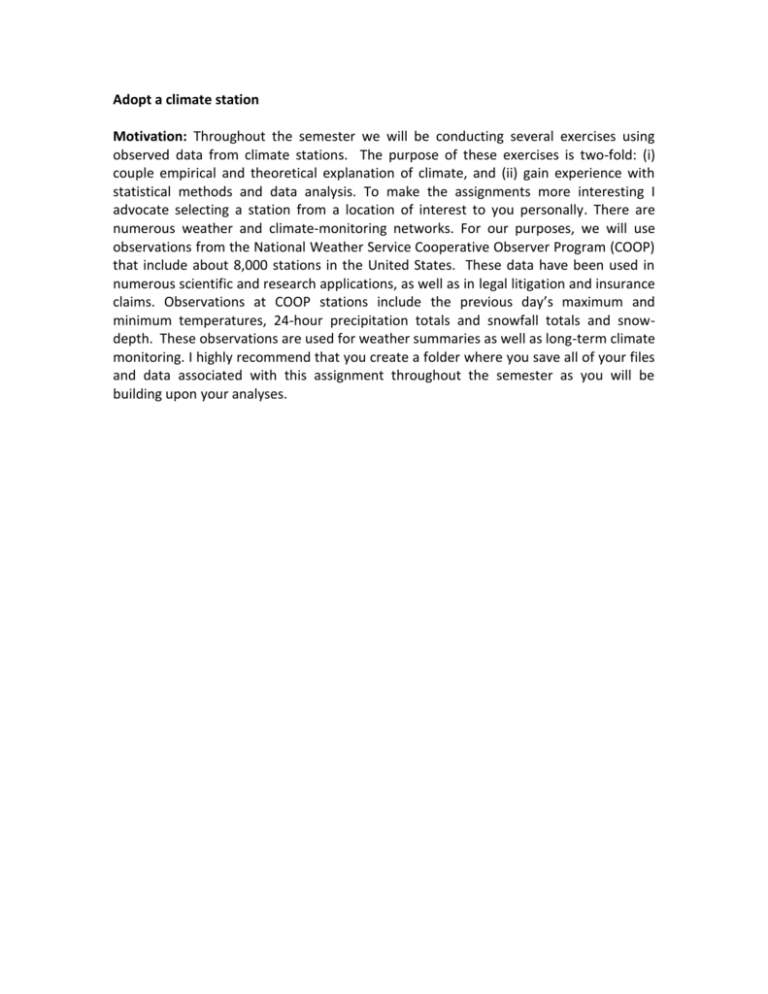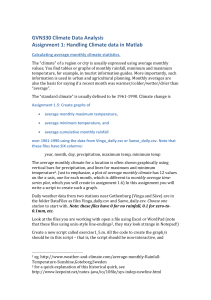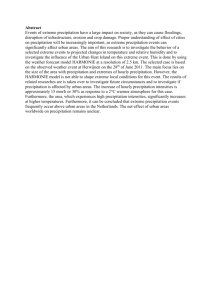Adopt A Climate Station
advertisement

Adopt a climate station Motivation: Throughout the semester we will be conducting several exercises using observed data from climate stations. The purpose of these exercises is two-fold: (i) couple empirical and theoretical explanation of climate, and (ii) gain experience with statistical methods and data analysis. To make the assignments more interesting I advocate selecting a station from a location of interest to you personally. There are numerous weather and climate-monitoring networks. For our purposes, we will use observations from the National Weather Service Cooperative Observer Program (COOP) that include about 8,000 stations in the United States. These data have been used in numerous scientific and research applications, as well as in legal litigation and insurance claims. Observations at COOP stations include the previous day’s maximum and minimum temperatures, 24-hour precipitation totals and snowfall totals and snowdepth. These observations are used for weather summaries as well as long-term climate monitoring. I highly recommend that you create a folder where you save all of your files and data associated with this assignment throughout the semester as you will be building upon your analyses. Assignment #1: Climatological summaries Due Date: 6 Feb, 2015 You will need to identify an active “long-term” climate station located in the United States from the Global Historical Climate Network (GHCN) using: http://www.wrcc.dri.edu/wwdt/time/ Choose: Retrieval Method of “United States Historical Climatology Network Stations” Please investigate the structure of the files acquired from this site and note that the data you acquire will consist of the entire period of record, or lifetime of the station. Tasks. 1. Acquire monthly mean temperature and accumulated precipitation data via by selecting the “All Months” box in the right hand column. Save the text output as a .csv or .txt file. Alternatively, this can be “copy and pasted” into MATLAB. You will have to organize your data into a workable database that you are comfortable using. Document the exact station name and ID (5 or 6 digit number). 2. Identify the site-specific information for your station. This should include the following: (i) latitude, longitude and elevation, and (ii) how many times [and dates] the station has been relocated. Visit http://www.ncdc.noaa.gov/homr/ to investigate the history of the station, and in particular changes in the location (latitude, longitude, elevation). Document this information on your assignment. 3. If your data contains any missing months (denoted by -9999.00). Replace missing data with estimated values obtained from the WestWide Drought Tracker a. Go to http://www.wrcc.dri.edu/wwdt/time/ b. Select, “Single 4x4km pixel from gridded dataset” Enter latitude and longitude of your station. c. Replace all missing data with estimates from time series. 4. Convert all data to standard scientific units of degrees Celsius and millimeters. 5. Calculate monthly climate normals for the years 1981-2010. Monthly normals are defined as the mean value for a 30-year reference period. Create a table that shows monthly normals. 6. Create a climograph of monthly temperature and precipitation normals a. EXCEL users can use a user-contributed template: http://nimbus.cos.uidaho.edu/abatz/CLASSES/GEOG401/HOMEWORK/Cli mateGraphTemplate.xls b. MATLAB users can use a function that I created: http://webpages.uidaho.edu/jabatzoglou/MATLAB/climograph.m >> climograph(temp,precip); function climograph assumes you send in monthly climatological temperature in degrees C and precipitation in mm. 7. Repeat #6 but showing only data from 2014. 8. Title your graphs explicitly. In MATLAB use the function title. (e.g., >> title(‘Climograph for Moscow Mountain, 1981-2010’); 9. Report the monthly anomalies for 2014 as departures from normal for mean temperature (in degrees C), and percent of normal for precipitation. Anomalies in climate terms are defined as deviations from 1981-2010 normals. These should be reported in a table with units labeled explicitly. 10. In a short paragraph, outline at least two theoretical factors that are important in the magnitude and seasonality of temperature and precipitation for your station. These can be hypotheses, rather than fact if you do not know. 11. Save your data, you will be using it in subsequent exercises. a. MATLAB users can save individual variables, or several variables using the function save. For example, if you wanted to save variables TEMP, and PPT in a file named mydata, you would execute the following: >> save mydata TEMP PPT This saves the data as a MATLAB binary. It is also possible to save the data as an ascii or excel compatible format. See MATLAB help for instructions on how to. Assignment #2: Trending Topics Due Date: 20 February 2015 Motivation: While the focus of this class is a more thorough understanding of climate science, climate change is a relevant component of climate literacy. The word change is somewhat deceiving as it implies that climate is stationary and suggests that any differences from some baseline condition are proof for or against change, let alone whether such changes are associated with natural variability or anthropogenic forcing. Detecting Trends: The issue of detecting trends in any dataset can be viewed statistically through the use of linear least-squares regression. Note that from a statistical sense, linear least squares regression fits a line to minimize the squares of the residuals (observations minus line). In this sense, the methodology can be sensitive to data outliers. It is also worth considering whether a linear trend is the appropriate approximation for a signal you are attempting to detect. A “trend” can technically be calculated for any dataset. However, in order to detect a statistically significant trend, one must further demonstrate the signal of the trend exceeds the noise of the data. Another way to think of this is that one must show that a trend is significantly different from the null hypothesis of no trend (trend = 0). We will consider statistical significance at the 95% confidence interval, or alternatively, results that would occur less than 5% of the time by chance in a purely randomly distributed dataset. MATLAB instructions: The formulas provided in the link above have been converted into a MATLAB function: http://webpages.uidaho.edu/jabatzoglou/MATLAB/lineartrend.m >> [trend, significance]=lineartrend(data,significancelevel); For example, if you want to test whether a trend is significant at the p<0.05 level you would execute the following: >> [trend,significance]=lineartrend(data,0.05); trend will return to you the slope of the line in units per year, significance will return a binary with 1=significant trend, 0= non-significant trend. Note that the MATLAB function will also account for autocorrelation in calculating the number of degrees of freedom. In EXCEL, you can use the GUI to get at your correlation, or function “CORREL” to calculate the correlation coefficient between years and your data You can then estimate significance by using the lookup table for r-values http://www.gifted.uconn.edu/siegle/research/Correlation/corrchrt.htm You'll need to know the number of degrees of freedom, which should be the length of your dataset minus 2. Tasks 1. Plot a time series of annual average temperature for your station from 19502014. a. Calculate the linear trend for the time period 1950-present and draw a linear least squares line to your plot. Report your trend in units of degrees Celsius per decade (note you may have to multiply trends that report in trend per year by 10). Report whether the calculated trend is significant or not at the p<0.05 level. Note: with excel you can estimate significance by correlating your time series to years. A p-value less than 0.05 is significant. b. Repeat (a) but using just summer (June-August) and winter (DecemberFebruary) temperatures. 2. Plot a time series of water year precipitation (Oct-Sep) for your station from 1950-2014. Water year precipitation for last water year is the sum of precipitation falling from Oct 2013 through September 2014. a. Repeat 1a and 1b for precipitation. 3. Complete the table below with the values you calculated. Place an asterisk for any trend that is statistically significant. Annual Winter Summer Temperature (C/dec) Precipitation (mm/dec) 4. What climatic factors could be hypothesized as resulting in the changes you found (if any)? 5. What non-climatic factors could result in detected change in temperature records that may be perceived as change to a naïve observer? Assignment #3: Sherlock Holmes of climatology Due: 6 March 2015 Motivation: The atmosphere is spatially and temporally auto correlated due to the presence of Rossby waves in mid-latitudes, preferred modes of climate variability, and the heat capacity of boundary conditions such as the oceans and soils. This typically results in climate anomalies with spatial characteristics that encompass large geographic areas and imply a top-down forcing of climate. In this exercise, you will explore some of the graphical tools produced by NOAA’s Earth System Research Laboratory. We will specifically focus on the use of monthly composites: http://www.esrl.noaa.gov/psd/cgi-bin/data/composites/printpage.pl Composites are essentially averages of samples of interest (often with some commonality) and calculated in very much the same way you calculated climate normals. However, when climatologists use composite analysis, they typically are interested in better understanding a phenomenon, how it differs from “normal”, and what larger-scale processes might be the culprit. For this exercise, you will comb through your stations temperature and precipitation records from 1948-2014 for the time period January-April (JFMA) and pick out the (i) top 5 warmest JFMA, (ii) top 5 coldest JFMA, (iii) top 5 wettest JFMA, and (iv) top 5 driest JFMA. For (i-iv) report the year and anomaly (temperature reported in degrees Celsius from 1981-2010 normal, precipitation reported in % of 1981-2010 normal). Your task here is to be a climate detective and identify possible suspects that may be responsible for the anomalous climate conditions identified in the common set of years. Note that by using a set of 5 years, composite analysis effectively tries to identify a signal (or repeated offenders) across the set of cases. Using the ESRL webpage, create composite maps of fields by: (i) choosing the variable and level of interest (ii) entering the years of interest into the boxes provided (iii) selecting plot type of “anomaly” (iv) selecting projection as PNA (Pacific-North America) region I will require you to examine at least the following dynamical fields. (a) Geopotential height at 500hPa: information on Rossby wave patterns (b) Vector wind at 250hPa: information on the jet-stream (c) Sea surface temperature (SST) anomalies from the NOAA OI dataset. Note, that you should use the global projection (“ALL”) to view potential teleconnections to the tropics for this variable For some of these patterns, you may also find that examining the mean in addition to the anomaly helpful. Your task is to present a description and supporting graphical evidence that implicates large-scale climate variability in the anomalous climate conditions for each of the four different climate extremes. Plan on a paragraph for each of the four extremes and back up your words using information derived from the composites. Assignment #4: Seasonal Climate Forecasts Due: 3 Apr, 2015 Motivation: Large-scale climate modes typically involving atmosphere-ocean coupling often result in significant climate anomalies that result in economic and ecological impacts. Fortunately, climate modes adhere to preferred patterns of development and global teleconnections, thus allowing for the potential of seasonal climate prediction and ultimately impact mitigation. Complex numerical models, such as those used by NOAA’s Climate Prediction Center, provide seasonal forecasts akin to weather forecasts through the interaction between long-lived boundary conditions and atmospheric circulation that ultimately are reflected in surface temperature and precipitation patterns using dynamical climate models. Other seasonal predictions are based off purely statistical relationships between known patterns and their influence on climate. In this exercise, you will be examining relationships between January-April temperature at your station versus a series of physical and non-physical drivers. The potential drivers, or predictors, of interest are: 1. Solar Flux at top of the atmosphere http://climexp.knmi.nl/data/itsi.dat 2. January monthly average S&P 500 http://www.measuringworth.com/datasets/sap/ 3. Eastern tropical pacific sea surface temperatures, NINO3.4 http://climexp.knmi.nl/data/inino5.dat 4. North pacific sea surface temperatures, PDO index http://climexp.knmi.nl/data/ipdo.dat For each time series above, we restrict the analysis of correlations to the time period 1980-2013. You should compute averages of your station data covering the time period Jan-Apr, and do likewise for each of the indices listed above. For the purpose of this exercise you can just use January averages for each of the predictors listed above since they are strongly serially correlated. Tasks 1. 2. Create four different scatter plots of the predictors (x-axis) versus station temperature (y-axis) for the years 1980-2013. I am also OK with you trying this experiment out with precipitation rather than temperature, your preference. Calculate the linear Pearson’s correlation between each predictor and temperature. In MATLAB use the function corr >> [rval,pval]=corr (predictor,temperature); In EXCEL use the function CORREL, see page 4 about The information you need to view is contained in rval: your Pearson’s correlation coefficient, and pval: your p-value for the given relationship. Statistically significant relationships will have pval<=0.05. 3. Discuss the sign of any significant relationships you identified in your analysis. If you did find a relationship, provide a hypothesis that would relate correlation to causation (e.g., how El Nino would result in warmer temperatures). If you failed to identify a relationship, discuss potential reasons why this may occur. Extra Credit [up to bonus 25% on a homework assignment] For each of the predictors, fit a linear least-squares regression between the predictor and station temperature using a model of the form: MYTEMP = α NINO34 + β (where NINO34 is an predictor) [eq. 1] In MATLAB use the function polyfit with polynomial value=1 (linear model) >> parameterfit=polyfit(NINO34,MYTEMP,1); Note that the first element of parameterfit, or parameterfit(1), is the sensitivity of your stations temperature to NINO3.4 (equivalent to α in eq. 1]. Plot the linear least squares fit on top of your scatterplot: >> plot(NINO34,MYDATA,’kd’,’markerfacecolor’,’k’); >> hold on % be sure to not erase your plot >> XXX=min(NINO34):1:max(NINO34); >> b=polyval(a,XXX); >> plot(XXX,b,’r’); % plot red linear least squares fit Build a prognostic (predictive) model to forecast seasonal temperature at your station for Jan-April 2015 using the results from #4. For this exercise, we will use the CFSv2 climate forecasts issued December 1st 2014 for NINO3.4 http://www.cpc.ncep.noaa.gov/products/people/wwang/cfsv2_fcst_history/201412/im agesInd3/nino34Mon.gif which puts the NINO34 = +0.7. Finally, qualitatively compare your forecast to the CPC seasonal forecasts (values in anomalies) http://www.cpc.ncep.noaa.gov/products/people/wwang/cfsv2_fcst_history/201412/in dex.html Assignment #5: Climate Classification and Water Balance Due: 24 April 2015 Climate Classification and Water Budget In this exercise we will be examining climate data at six sites across a transect of the eastern Columbian basin. These stations from west to east are: Connell, WA, La Crosse, WA, Pullman, WA, Moscow, ID and Elk River, ID. A map of these stations can be found here: http://alturl.com/c5ia3 MATLAB 1. Download the 1971-2000 climate normal and station metadata http://webpages.uidaho.edu/jabatzoglou/DATA/401/HW3DATA.mat - Temperature data is in degrees Celsius, precipitation data is in millimeters. - Variable VS is the monthly average wind speed in meters per second. - Variable RA is the monthly average insolation in W/m2. 2. Download the function to calculate potential evapotranspiration using the Pennman-Montieth method that accounts for include temperature, radiation, and wind data. Fortunately, I have provided these to you. http://webpages.uidaho.edu/jabatzoglou/DATA/401/monthlyPET_PM.m - This is a MATLAB function. Utilize it as follows: - >> PET=monthlyPET_PM(RA,TMAX,TMIN,VS,LON,LAT,EL); The output variable will be monthly PET in mm. 3. Download the simple hydrologic model that uses the bucket model to account for AET (actual evapotranspiration), runoff, and deficit. http://webpages.uidaho.edu/jabatzoglou/DATA/401/simplehydromodel.m - This is a MATLAB function, utilize as follows to run on station #1, repeat for other stations, but be sure to increment AET etc. accordingly. You can do this as a loop for efficiency sake as for i=1:5 [AET(i,:),DEF(i,:),RO(i,:)]=simplehydromodel(PPT(i,:),PET(i,:)); end - Note: This model assumes the soil can hold 150mm of moisture. EXCEL 1. Download the 1971-2000 climate normal and station metadata from http://alturl.com/c5ia3 2. Enter these values in the Water Balance Excel template: nimbus.cos.uidaho.edu/abatz/CLASSES/GEOG401/HOMEWORK/geog401_waterbalance. xls 3. For each station you will need to modify the latitude. You can set SOILmax (water holding capacity, at 150mm). Questions and Analysis 1. For each station, plot the annual precipitation (PPT), potential evapotranspiration (PET), actual evapotranspiration (AET) and deficit (DEF) on the same plot. Your x-axis should be months of the year. Label your axes and title your graphs, these will be turned in. If using MATLAB you can use the function http://webpages.uidaho.edu/jabatzoglou/MATLAB/waterbalancegraph2.m >>waterbalancegraph2(PPT(1,:),AET(1,:),DEF(1,:),PET(1,:)) a. Quantify the difference in (PPT-PET) between Elk River, ID and Connell, WA. b. Wheat grown across the Columbia basin includes both dryland farming that does not require agriculture and irrigated farmland that does. Winter wheat typically grows between Jan and May and productively scales with energy and moisture requirements. For each of the sites, estimate the amount of additional moisture required to avoid moisture stress (or deficit) between the months of January through May. 2. A more detailed analysis of “sprinkler season” in Moscow Idaho. a. During what month(s) of the year is there a deficit in moisture availability for Moscow, ID? b. The annual moisture deficit corresponds to the amount of water needed to supply a reference crop with enough water to ensure optimal productivity. How much extra irrigation is needed in Moscow to avoid a deficit? Joe Vandal feels the need to keep a green lawn on the admin lawn. During the month of July, assuming he waters every third day and the sprinkler system delivers about 60mm/hour, how long does he need to run the sprinkler system? c. During a particularly warm year where maximum and minimum temperature are 3C above normal the irrigation requirement might change. Repeat 2b for Joe Vandal’s lawn during a particularly warm year. This will require recalculating PET and re-running your water balance calculations. 3. Ignoring the fact that the stations are over 100km apart, estimate the lapse rate and orographic precipitation ratio (change in precipitation as a function of elevation) for the study area. This will require running a linear least squares regression using annual precipitation or temperature data. You might want to do this separately for maximum and minimum temperature. Report your regressions in units of degrees Celsius per km (for temperature) or mm per km (for precipitation). Assignment #6: Prehistoric vegetation Note: Extra Credit Assignment Due: 8 May 2015 Motivation: There are numerous affiliated disciplines to climatology, with an increasing demand to integrate climate information to solve questions of today and tomorrow. For this assignment we will be looking at a question from long ago that has relevant implications for problems of today and tomorrow. Your task is to deduce macroscale vegetation distribution at your climate station during the last glacial maximum without using a Delorean or a shovel. Using 1981-2010 climate normals from assignment 1, you will derive some simplified water balance metrics for your specific site. We will use the Thornthwaite equation for estimate site-specific potential evapotranspiration using monthly temperature and day length (function of latitude). The equation is provided below for reference. Ii = (Ti/5)1.514 T: monthly temperature in degrees Celsius J = ∑i=112(Ii) c = 0.000000675J3 - 0.0000771J2 + 0.01792J + 0.49239 PETi = 1.6(10Ti/J)c *(N/30)*(L/12) N: days in month, L:day length (hours) MATLAB 1. function thronPET calculates the aforementioned PET for you, here climotemp is the climatological monthly mean temperature, latitude is the latitude of the station of interest. http://webpages.uidaho.edu/jabatzoglou/MATLAB/thornPET.m [PET]=thornPET(climotemp,latitude); 2. function simplehydromodel calculates the monthly water balance for inputs of PPT (precipitation), PET (potential evapotranspiration) and AWC (soil water holding capacity, you can assume your site has 150mm). Outputs returned are AET, DEF, and RUNOFF in units of mm. [AET,DEF,RUNOFF]=simplehydromodel(PPT,PET,AWC); EXCEL Use the Water Balance Excel template: nimbus.cos.uidaho.edu/abatz/CLASSES/GEOG401/HOMEWORK/geog401_waterbalance. xls You will examine (i) potential evapotranspiration (PET), (ii) actual evapotranspiration (AET), and (iii) deficit (DEF). Tasks 1. Estimate the total annual potential evapotranspiration, actual evapotranspiration and deficit in units of mm using Thornthwaitte equation. 2. Use the plot below from Stephenson (1998) below to estimate the type of vegetation biome in your site. Figure 1: Distribution of major North American biomes relative to AET and Deficit. 3. We’d like to know what biome existed in your site during the last glacial maximum. One method of doing this would be to identify sediment or fossil geologic vegetation. Another means, would be to take the result of paleo global climate modeling exercises and reassess the moisture balance at your specific site. While fieldwork sounds fun, in the interest of time, we’ll opt for the latter. In this case I am providing modeling results from the Paleoclimate Modeling Intercomparison Project available from USGS http://regclim.coas.oregonstate.edu/visualization/gccv/cmip5-global-climatechange-viewer/index.html that show modeled changes in precipitation (see caption below on how to use this information) and Surface Air Temperature (SAT). Please note that the figures show the difference between the LGM (Last Glacial Maximum) and MOD (modern, present-day climate). Using these maps, your task is to rerun calculations for both potential evapotranspiration and AET/deficit, and to then use the plot above to estimate the biome that might have existed at your station 18,000 years ago. 4. Extra Credit: Perform the same exercise, except project future macroscale vegetation distribution by the end of the 21st century (2080s) under an aggressive emission scenario (SRES-A2) for the multimodel ensemble (mean of several different GCM) using http://www.climatewizard.org/ the information provided at: You will need to identify the mean annual change in temperature and precipitation, and rerun your calculations of PET and water balance. Figure 2: Difference in precipitation between the last glacial maximum (LGM) and present day conditions (MOD) as simulated by GCMs. You will need to convert these values reported in mm/day to the appropriate scales for your calculations. Figure 3: Difference in surface air temperature between the last glacial maximum (LGM) and present day conditions (MOD) as simulated by GCMs.









